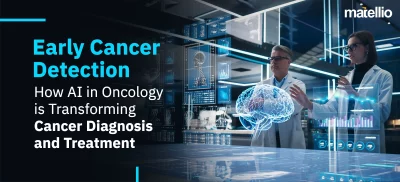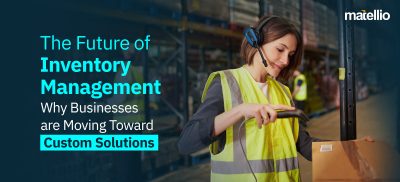
In the internet age, connectivity is everything. Today, almost every aspect of our lives can be governed and enhanced using the internet. From connecting people separated by great distances to allowing you to order things online, internet has changed our lives in countless ways.
But at the end of the day, internet is nothing but the exchange of data between different parties.
Every time we use the internet, we are either sending some information/instructions or receiving it. And in the digital age, we are creating more data than ever before. Every activity we perform online gets stored and used to improve online services and provide more personalized services and experiences.
With that in mind, it wouldn’t be a stretch at all to say that from a business point of view, data is the king.
But due to the growing competition, customer expectations, and the complexity of business processes, traditional internet is just not enough.
Ever since Kevin Ashton first coined the term Internet of Things in 1999, this technology has been on a constant rise. Today, IoT is perhaps the hottest technology on the block that has penetrated both consumer and business sectors to a great extent.
From the healthcare sector to defense and research, IoT is revolutionizing almost all industries, allowing them to work more efficiently and smartly. It also enhances the quality of services and products delivered to the end users, increasing revenue, market share, and brand dependence.
One such sector that IoT has completely transformed is transportation and logistics. IoT in transportation and logistics is helping companies streamline their delivery routes and cut back on operation costs. Among the many benefits of IoT in transportation, one is the ability for fleet managers to monitor and control their vehicles remotely. Thanks to real-time data collection, fleet managers know the exact location of their vehicles, along with information like their average speed, idle time, etc. This data helps fleet managers train their drivers to minimize fuel consumption, deliver time, and the company’s environmental impact.
In this article, we will learn about the five ways IoT in transportation and logistics is changing the industry.
IoT in Transportation
Before we move on to learn about the exciting transformations IoT is bringing to the transportation and logistics sector, let’s know a little about how IoT is used in the transportation market.
IoT is the technology that connects various net-enabled devices with each other and a back-end server.
Now, you might ask yourself: how is that different from the normal internet? Well, the key difference between the two is that the Internet of Things is an internet network, but between smaller devices with less computational powers.
So with IoT, the devices you wouldn’t expect to have internet connectivity, like microwaves or water pumps, can have internet connectivity and be controlled remotely.
On top of these devices, various sensors such as light, motion, temperature, etc., are also a part of the IoT device family.
IoT in transportation is mainly concerned with the tracking of vehicles and goods. In large companies with hundreds of vehicles delivering goods to distant locations, it becomes necessary for fleet managers to monitor them.
Vehicles are fitted with various IoT devices that send the real-time location data to the fleet manager, along with other details about the vehicle such as average speed, harsh braking and acceleration instances, idle time, etc.
The data collected by the IoT device is sent to the back-end server with the help of a mobile network. On the back-end, the fleet manager uses an IoT-based software solution to access the data transmitted by different vehicles. On top of being able to see the data, fleet managers can also get detailed analysis of the data and gain insights into any driver’s driving habits. Using AI models and machine learning, IoT software solutions can create detailed reports about various journeys and provide suggestions on how to cut back on costs and preserve fuel.
Fleet managers can also get weather and traffic reports depending on how deep the features of their transportation management software are. Based on the information received, the software can suggest the optimal route for the drivers. This ensures driver safety and the speedy delivery of the goods.
You can learn more about how IoT is changing the transportation and logistics sector here.
5 Ways IoT is Transforming the Transportation and Logistics Industry
Now that we know how IoT in transportation works, let us look at the top 5 ways the transportation industry has benefited from IoT.
Geolocation
Whether it is for public transport or logistics and goods delivery, geolocation is the most significant IoT implementation in the sector.
As discussed in the previous section, fleet managers are always aware of their vehicles’ locations thanks to real-time location data transfer. IoT also makes vehicles secure. Using geolocation, stealing a vehicle becomes more difficult since fleet managers can track it easily.
Furthermore, drivers can also keep track of their routes and make adjustments according to the data provided by fleet managers.
Customers can also track their delivery using IoT mobile apps and other solutions.
Besides logistics, the transport sector can also use IoT for smart fare calculations for live location updates. Transportation can be much more efficient and safer for businesses and users when combined with geo-fencing.
Other benefits, such as live traffic updates, remote access, operation cost, pollution reduction, etc., are also enjoyed by the companies that invest in IoT in transportation and logistics.
Vehicle Monitoring and Compliance
Vehicle health can become a concern for long runs. If not monitored properly, poor vehicle health can put the safety of the driver and the goods in jeopardy. IoT devices embedded in vehicles can transfer vehicle health data to fleet managers. The data is sent over a mobile network in small packets to ensure that the data goes through even in low connectivity areas.
The fleet managers can maintain detailed vehicle health analysis and reports on the back-end, and according to company policy, they can raise repair alarms. This way, IoT helps transport and logistics companies run their operations safely.
IoT in transportation can also help businesses adhere to various compliances as well. For example, an IoT sensor can be embedded in a vehicle to relay the TMPS readings, ensuring maximum load compliance for road travel.
Simple radar-based sensors can also be linked to public vehicles to get real-time updates on passengers and notify them of upcoming stops and seat availability. Many such sensors can be used with IoT to improve the transportation business’s functioning in many ways.
Using IoT devices, transportation business owners can ensure that the vehicles are used optimally, the drivers follow the rules and regulations, and the goods/passengers are transported safely.
Fleet management
IoT in transportation helps businesses manage their fleets more efficiently and run their supply chain processes in a streamlined fashion. Smart fleet management becomes necessary in big industries such as manufacturing, where goods are transported from different places to be assembled in factories. In time-critical projects, even a slight delay in the delivery or damage to the goods can be an expensive blow. To prevent that from happening, companies track their deliveries down to the most granular aspects.
To ensure optimum deliveries, vehicle condition and driver health are monitored carefully using IoT-based software solutions.
IoT sensors provide real-time information about the vehicle, ensuring the cloud based fleet management system gets all the necessary information to run the fleet effectively. And as more sophistication comes to IoT in transportation and logistics, we will see better software and processes built around them.
Also Read- IoT Fleet Management- Use cases, Benefits and Features
Next-gen Tech Integration
While IoT is a powerful tool, it can become unstoppable when coupled with other next-gen technologies like AI and Big Data.
One of the fundamental concepts of IoT is real-time data collection. Whether we are talking about IoT in transportation or any other industry, the massive amount of data collected by IoT devices is why it is so popular. But data collection is only one part of the picture.
Once collected, the data needs to be used to get critical insights and detailed analysis. This is where next-gen tech, such as artificial intelligence, comes in. The amount of data collected by IoT devices is so much that no person can manually sift through it and find trends and other details.
But an AI can.
Most IoT transport management software has advanced AI implementation that provides charts and graphs for trend projections.
On top of that, these technologies can also help users build better strategies that cut back on costs and elevate revenues.
When integrated with IoT in transport and logistics, these technologies can help business elevate their services and become efficient.
Inventory Management
IoT services are helping the logistics industry solve the problem of inventory management. Big retail stores can’t afford to run out of stock. It damages their reputation and costs them a lot of money. That is why smart inventory management is becoming such a growing trend.
With competent IoT implementation, retailers never have to worry about running out of goods. As soon as the system detects the stock running low on a product, it places the order automatically. Then, with the help of IoT sensors, it also keeps track of the delivery.
Another great thing about IoT in inventory management is that it doesn’t simply place orders for everything. It takes into consideration parameters like product popularity. This prevents businesses from ordering goods that are simply not selling.
Also Read: IoT Consulting Services: Everything You Need to Know
Conclusion
IoT in transportation and logistics industry has recently gained much popularity. From being able to remotely monitor and control their fleets to being able to assess vehicle health and passenger capacity, businesses are using IoT for a plethora of processes. Thanks to IoT, the transportation and logistics industry is becoming more streamlined, efficient, and less hazardous to the environment. By optimizing their fuel consumption, businesses are not only decreasing their cost the harmful emission released into the air.
If you are looking to hire IoT developer, Matellio has years of experience developing top-notch IoT software solutions for the transport and logistics industry. Our experienced IoT developers and consultants can help you transform your IoT app idea into a reality. Using cutting-edge technology, we build IoT software solutions that help you become more efficient and elevate the quality of your services.
Learn more about our IoT development services.





